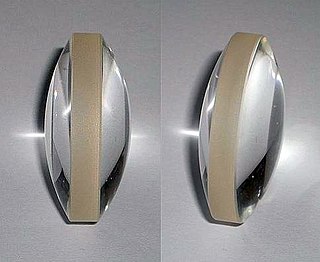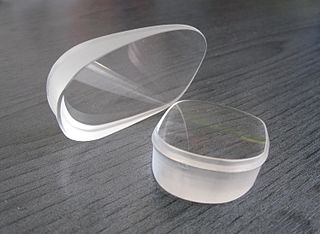
A lens is a transmissive optical device that focuses or disperses a light beam by means of refraction. A simple lens consists of a single piece of transparent material, while a compound lens consists of several simple lenses (elements), usually arranged along a common axis. Lenses are made from materials such as glass or plastic, and are ground and polished or molded to a desired shape. A lens can focus light to form an image, unlike a prism, which refracts light without focusing. Devices that similarly focus or disperse waves and radiation other than visible light are also called lenses, such as microwave lenses, electron lenses, acoustic lenses, or explosive lenses.

Ophthalmology is a branch of medicine and surgery, which deals with the diagnosis and treatment of eye disorders. An ophthalmologist is a specialist in ophthalmology. The credentials include a degree in medicine, followed by additional four to five years of ophthalmology residency training. Ophthalmology residency training programs may require a one year pre-residency training in internal medicine, pediatrics, or general surgery. Additional specialty training may be sought in a particular aspect of eye pathology. Ophthalmologists are allowed to use medications to treat eye diseases, implement laser therapy, and perform surgery when needed. Ophthalmologists may participate in academic research on the diagnosis and treatment for eye disorders.
Bausch + Lomb is a Canadian eye health products company based in Laval, Quebec, Canada. It is one of the world's largest suppliers of contact lenses, lens care products, pharmaceuticals, intraocular lenses, and other eye surgery products. Founded in Rochester, New York in 1853 by optician John Bausch and financier Henry Lomb, Bausch + Lomb is one of the oldest continually operating companies in the US.

Glasses, also known as eyeglasses or spectacles, are devices consisting of glass or hard plastic lenses mounted in a frame that holds them in front of a person's eyes, typically using a bridge over the nose and arms which rest over the ears.

A contact lens, or simply contact, is a thin lens placed directly on the surface of the eye. Contact lenses are considered medical devices and can be worn to correct vision, or for cosmetic or therapeutic reasons. In 2004, it was estimated that 125 million people worldwide use contact lenses, including 28 to 38 million in the United States. In 2010, the worldwide market for contact lenses was estimated at $6.1 billion, while the US soft lens market was estimated at $2.1 billion. Multiple analysts estimated that the global market for contact lenses would reach $11.7 billion by 2015. As of 2010, the average age of contact lens wearers globally was 31 years old, and two-thirds of wearers were female.

Near-sightedness, also known as short-sightedness and myopia, is an eye disorder where light focuses in front of, instead of on, the retina. This causes distant objects to be blurry while close objects appear normal. Other symptoms may include headaches and eye strain. Severe near-sightedness increases the risk of retinal detachment, cataracts, and glaucoma.

A cataract is a clouding of the lens in the eye which leads to a decrease in vision. Cataracts often develop slowly and can affect one or both eyes. Symptoms may include faded colors, blurry or double vision, halos around light, trouble with bright lights, and trouble seeing at night. This may result in trouble driving, reading, or recognizing faces. Poor vision caused by cataracts may also result in an increased risk of falling and depression. Cataracts cause half of all cases of blindness and 33% of visual impairment worldwide.

Sunglasses or sun glasses are a form of protective eyewear designed primarily to prevent bright sunlight and high-energy visible light from damaging or discomforting the eyes. They can sometimes also function as a visual aid, as variously termed spectacles or glasses exist, featuring lenses that are colored, polarized or darkened. In the early 20th century, they were also known as sun cheaters.

The lens is a transparent, biconvex structure in the eye that, along with the cornea, helps to refract light to be focused on the retina. The lens, by changing shape, functions to change the focal distance of the eye so that it can focus on objects at various distances, thus allowing a sharp real image of the object of interest to be formed on the retina. This adjustment of the lens is known as accommodation. Accommodation is similar to the focusing of a photographic camera via movement of its lenses. The lens is more flat on its anterior side than on its posterior side.

Far-sightedness, also known as hyperopia, is a condition of the eye in which light is focused behind, instead of on, the retina. This results in close objects appearing blurry, while far objects may appear normal. As the condition worsens, objects at all distances may be blurry. Other symptoms may include headaches and eye strain. People may also experience accommodative dysfunction, binocular dysfunction, amblyopia, and strabismus.

Presbyopia is a condition associated with the aging of the eye that results in progressively worsening ability to focus clearly on close objects. Symptoms include difficulty reading small print, having to hold reading material farther away, headaches, and eyestrain. Different people will have different degrees of problems. Other types of refractive errors may exist at the same time as presbyopia.
Photophobia is a symptom of abnormal intolerance to visual perception of light. As a medical symptom, photophobia is not a morbid fear or phobia, but an experience of discomfort or pain to the eyes due to light exposure or by presence of actual physical sensitivity of the eyes, though the term is sometimes additionally applied to abnormal or irrational fear of light such as heliophobia. The term photophobia comes from the Greek φῶς (phōs), meaning "light", and φόβος (phóbos), meaning "fear". Photophobia is a common symptom of visual snow.

A Klieg light is an intense carbon arc lamp especially used in filmmaking. It is named after inventor John Kliegl and his brother Anton Kliegl. Klieg lights usually have a Fresnel lens with a spherical reflector or an ellipsoidal reflector with a lens train containing two plano-convex lenses or a single step lens.

Ophthalmoscopy, also called funduscopy, is a test that allows a health professional to see inside the fundus of the eye and other structures using an ophthalmoscope. It is done as part of an eye examination and may be done as part of a routine physical examination. It is crucial in determining the health of the retina, optic disc, and vitreous humor.

The ciliary muscle is a ring of smooth muscle in the eye's middle layer that controls accommodation for viewing objects at varying distances and regulates the flow of aqueous humor into Schlemm's canal. It changes the shape of the lens within the eye, not the size of the pupil which is carried out by the sphincter pupillae muscle and dilator pupillae.
Aphakia is the absence of the lens of the eye, due to surgical removal, a perforating wound or ulcer, or congenital anomaly. It causes a loss of accommodation, far sightedness (hyperopia), and a deep anterior chamber. Complications include detachment of the vitreous or retina, and glaucoma.
Essilor International S.A. is a French-based international ophthalmic optics company that designs, manufactures and markets lenses to correct or protect eyesight. Its headquarters is based in Charenton-le-Pont, France. Essilor is quoted on the Euronext Paris Stock Exchange. It is a component of the Euro Stoxx 50 share index.
Pseudoexfoliation syndrome, often abbreviated as PEX and sometimes as PES or PXS, is an aging-related systemic disease manifesting itself primarily in the eyes which is characterized by the accumulation of microscopic granular amyloid-like protein fibers. Its cause is unknown, although there is speculation that there may be a genetic basis. It is more prevalent in women than men, and in persons past the age of seventy. Its prevalence in different human populations varies; for example, it is prevalent in Scandinavia. The buildup of protein clumps can block normal drainage of the eye fluid called the aqueous humor and can cause, in turn, a buildup of pressure leading to glaucoma and loss of vision. As worldwide populations become older because of shifts in demography, PEX may become a matter of greater concern.

Eye care professionals use prism correction as a component of some eyeglass prescriptions. A lens which includes some amount of prism correction will displace the viewed image horizontally, vertically, or a combination of both directions. The most common application for this is the treatment of strabismus. By moving the image in front of the deviated eye, double vision can be avoided and comfortable binocular vision can be achieved. Other applications include yoked prism where the image is shifted an equal amount in each eye. This is useful when someone has a visual field defect on the same side of each eye. Individuals with nystagmus, Duane's retraction syndrome, 4th Nerve Palsy, and other eye movement disorders experience an improvement in their symptoms when they turn or tilt their head. Yoked prism can move the image away from primary gaze without the need for a constant head tilt or turn.
Iridodonesis is the vibration or agitated motion of the iris with eye movement. This may be caused by lens subluxation, the incomplete or partial dislocation of the lens; or by aphakia, the absence of a lens. The term originated from irido- + doneo.













